“Intelligent drive”


“New S-Class with all-round vision”
Prof. Dr. Thomas Weber is the Member of the Daimler Board of Management responsible for Group Research and Head of Mercedes-Benz Cars Development. We spoke to him about the potential of the new safety systems.
Prof. Weber, “Intelligent Drive” is the slogan for this TecDay. What exactly does Mercedes-Benz understand by this term?
Whereas before, assistance systems could be clearly classified under the categories of comfort or safety, the boundaries are more fluid today. For us, “Intelligent Drive” is the intelligent interlinking of sensors and systems to create a new dimension of motoring.
The car was already given the gift of sight some years ago thanks to a multitude of sensors and cameras. What new capabilities are being added now?
The intelligent assistance systems of the future will be able to analyse increasingly complex situations and recognise potential dangers out on the road with the aid of improved environment sensor systems even more accurately than today.
Amalgamating the algorithms that extract their data from the further improved radar sensors and the new stereo camera is also crucial for the new functions. We call this “sensor fusion”.
The new Brake Assist system BAS PLUS with Cross-Traffic Assist, for instance, is now also able to detect cross traffic and pedestrians for the first time. And PRE-SAFE® PLUS can trigger precautionary measures when there is a risk of a collision from the rear. Figuratively speaking, the next S-Class won’t just have eyes at the front, it will have 360-degree all-round vision.
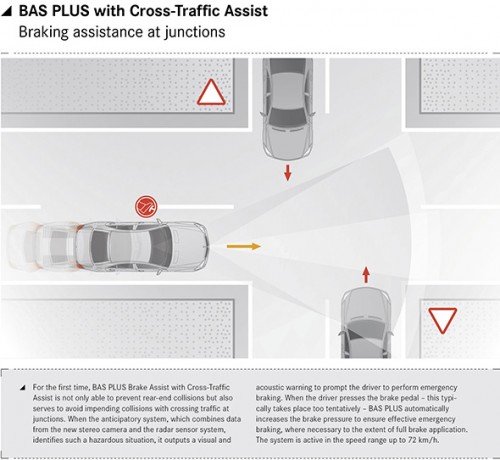
You just mentioned pedestrian detection. So, the new safety systems don’t just protect the Mercedes driver and their passengers, but other road users, too?
Yes, it shouldn’t be just our own customers who reap the benefits of our superior safety expertise, but other road users as well of course. Take the spotlight function of the Night View Assist PLUS, for instance, which allows pedestrians to be spotted in the dark and flashed with pinpoint accuracy.
By so doing, not only are we warning the driver, but the pedestrian, too. Another example is the new tail light clusters with their multi-level functionality. Here, the brake lights and indicators are operated at varying intensities depending on the current driving state.
If the Mercedes driver presses the brake pedal while stopped at traffic lights, for instance, the brightness of the brake lights will be automatically dimmed to avoid dazzling anyone behind.
What sort of improvement in the accident figures do you expect the new assistance systems to bring about? Is the vision of accident-free driving due to become a reality soon?
The vision of accident-free driving spurs us on to set ambitious goals. At the same time, though, the vision of accident-free driving is exactly that: a vision. We work very hard to minimise the number of accidents and the severity of injuries with ever newer safety technologies and our own in-house accident research.
But we can’t promise the impossible, simply because humans are prone to make the occasional error – including at the wheel of a car. And this is precisely why we need new systems that come to the driver’s aid in critical situations. Consequently, the new systems hold great potential.
Take, for instance, the new assistance system BAS PLUS with Cross-Traffic Assist: the results of our accident research based on the data from the GIDAS (German In‑Depth Accident Study) indicate that it could either prevent or lessen the severity of 27 percent of all accidents at road junctions resulting in personal injury. That equates to some 20,000 accidents a year in Germany alone.
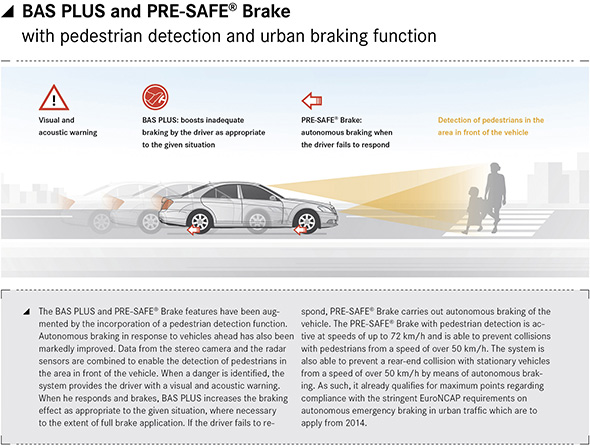
When will we get the autonomous car?
A decade ago, technologies that are taken for granted today were regarded by many as just wishful thinking. For that reason, I am certain that we will keep getting closer and closer to the notion of autonomous driving, too.
By no means do we wish to take over control from the driver, however. Instead, the aim is to relieve motorists when driving is more of a burden than a pleasure – on the monotonous daily commute, for example, or in stop-and-go traffic.
From a purely technical standpoint, that’s already possible now to a certain extent. The new S-Class is equipped with systems that include the necessary means to do the same in complex traffic situations, too. In this way, comfort and safety systems merge together into a new dimension of motoring, opening up brand new prospects.
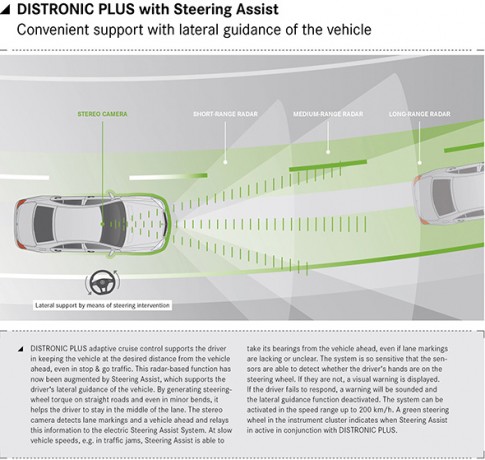
Under the microscope: the new sensors
Intelligent networking of eyes and ears
Highly sophisticated sensors and the necessary networked algorithms provide the foundation for innovative new functions. DISTRONIC PLUS with Steering Assist, BAS PLUS and PRE-SAFE® Brake all employ sensor fusion using the same stereo camera and multistage radar sensors.
Mercedes-Benz is making a major leap forward with the introduction of the Stereo Multi-Purpose Camera (SMPC), or stereo camera for short. Just like the Multi-Purpose Camera (MPC) fitted previously, it is positioned behind the windscreen in the vicinity of the rear-view mirror.
It has an opening angle of 45° and is capable of three dimensional detection of crossing objects and pedestrians, and calculating their path. The camera’s two “eyes” provide it with a three-dimensional view of the area up to around 50metres in front of the vehicle, and it is able to monitor the overall situation ahead for a range of up to 500 metres.
In this way, the new camera is able to provide data for processing by various systems.
Intelligent algorithms evaluate this information in order to detect and carry out spatial classification of both vehicles that are driving ahead, oncoming or crossing, as well as pedestrians and a variety of traffic signs within a large field of vision.
Whereas the stereo camera’s lenses act as the car’s eyes, the radar sensors are its ears, so to speak, and provide additional data. The system of radar sensors comprises two short-range radar sensors in the front bumper with a range of 30 m, opening angle 80°, which are complemented by a long-range radar sensor (range 200 m, opening angle 18°) including mid-range scan (60 m, 60°).
The data from the camera and radars is amalgamated in a control unit in order to provide the system-specific data for the various functions.
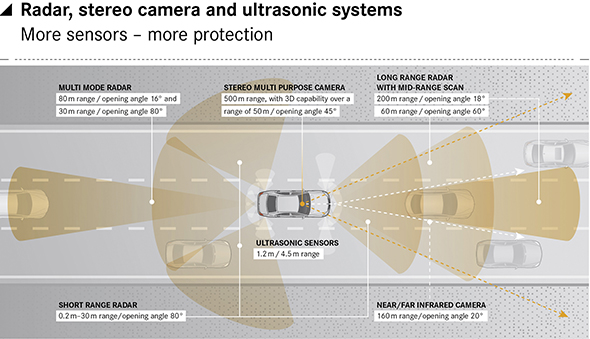
Here is a summary of the sensors and cameras:
- Radars:
- 2 short-range radar sensors at the front (30 m, 80°)
- 1 long-range radar sensor at the front (200 m, 18°)
with mid-range detection (60 m, 60°) - 2 short-range radar sensors on the sides at the rear
(30 m, 80°)- 1 multi-mode radar sensor at the rear (30 m, 80°
and80 m, 16°)
- 1 multi-mode radar sensor at the rear (30 m, 80°
- Stereo camera (Stereo Multi-Purpose Camera, SMPC) located behind the windscreen in the vicinity of the rear-view mirror (range500 m, incl. 3D capability for approx.50 m, 45°)
- 12 ultrasonic sensors (4 each at the front / rear + 2 each on the left / right in the front and rear bumpers)
- 4 cameras as 360° camera system (1 each at the front in the radiator grille / at the rear in the boot handle recess / on the bottom of the exterior mirror housings, vertical approx. 130°, horizontal > 180°, resolution 1 megapixel (1280 – 800 px)
An extensive system of additional internal sensors is able to keep an eye on the current driving state and the driver’s reactions. If the sensors detect a hazardous situation, they are able to feed the algorithms for all manner of assistance systems with data in order to provide just the right support for the specific situation.
New assistance systems
The helpers in the background
Avoid accidents and mitigate their consequences – this is the integrated approach adopted by Mercedes-Benz Accident Research under the heading “Real Life Safety”. Mercedes-Benz is systematically pursuing this strategy with numerous new assistance systems and greatly enhanced functions.
The new functions all rely on the same sensor system, comprising a new stereo camera together with multistage radar sensors.
The support functions range from relieving the burden on the driver and therefore increasing comfort, to issuing visual, acoustic and/or haptic warning signals, to enhancing the driver’s reactions. Some systems are even able to take corrective action in an emergency, such as autonomous applications of the brakes to prevent an accident or reduce its severity.
Comfort-enhancing assistance with lateral lane guidance: DISTRONIC PLUS with Steering Assist
The DISTRONIC PLUS adaptive control system is a driver aid designed to keep the vehicle at the desired distance from another vehicle in front that is travelling slower than the selected cruising speed. This radar-based function has now been enhanced by the addition of Steering Assist, which helps drivers to stay centred in their lane by generating the appropriate steering torque when travelling on a straight road and even in gentle bends.
The stereo camera recognises lane markings as well as vehicles driving ahead together with their three-dimensional positioning, and relays this information to the electric steering assistance system.
When driving at slow speeds, e.g. in congested traffic, Steering Assist can use the vehicle ahead as a means of orientation, enabling semi-autonomous following even when there are no clear lane markings visible. As a result, the system is able to further enhance driving comfort and substantially ease the driver’s workload in many traffic situations.
The new Steering Assist function integrated into the DISTRONIC PLUS system is predominantly based on the new stereo camera (see previous section). At the same time, the area in front of the vehicle continues to be monitored by two short-range radar sensors and a long-range radar sensor with medium-range detection.
The system fuses the data gleaned from both technologies, calculates any reactions required, and then regulates the vehicle’s speed as requirements dictate by controlling engine power, transmission and brakes, as well as actuating the electric steering for lateral vehicle guidance.
DISTRONIC PLUS with Steering Assist can be activated as before with a lever on the steering column in a speed range from 0 -200 km/h. Any speed between30 km/hand200 km/hcan be selected as the desired cruising speed.
A green steering wheel symbol appears in the instrument cluster to indicate when Steering Assist is operating while DISTRONIC PLUS is activated. Meanwhile, longitudinal information (cruise control function) is still visualised in the speed display by means of circular segments and the speedometer needle.
Drivers must keep their hands on the steering wheel at all times even when Steering Assist is activated, as the function only works in bends above a certain, speed-dependent radius. Legal considerations also mean there are no plans to introduce hands-free driving.
The system’s design is so refined that the sensors can detect whether the driver’s hands are actually on the steering wheel. If they are not, a visual warning is issued first. Should the driver fail to react to this prompt, a warning signal sounds and lateral lane guidance is deactivated.
This does not affect the cruise control function, however, which continues to be operative. Needless to say, the driver is able to override the Steering Assist at any time. If the driver signals to change lane, for instance, the lateral guidance function will switch into passive mode for the duration of the lane change.
The longitudinal performance capabilities of DISTRONIC PLUS have been further refined. Now, the system is able to brake at a rate of up to 5 m/s² without any intervention from the driver. If the “S” drive mode button is pressed, the rate of acceleration increases, too. Vehicle acceleration is also more dynamic if the driver signals a wish to overtake by switching on the indicators, assuming the road is clear.
By combining radar and camera data, DISTRONIC PLUS is also able to detect both vehicles cutting in and vehicles ahead in adjacent lanes and take necessary action promptly. This can prevent illegal undertaking on motorways and multi-lane highways, for example, by adapting the speed to that of vehicles in the outside lanes.
Braking assistance for crossing traffic: BAS PLUS with Cross-Traffic Assist
City junctions are a major accident blackspot. The collisions here can mostly be put down to driver distraction or misjudgement. Whereas humans often react too slowly, assistance systems are immune to that brief moment of shock.
Apart from material damage, accidents at junctions often result in serious personal injuries, too. The new Brake Assist BAS PLUS from Mercedes-Benz is therefore capable of more than just helping the driver to avoid collisions with vehicles ahead or lessen their consequences in a purely longitudinal direction: the new Cross-Traffic Assist function can also come to the driver’s aid when there is a risk of a collision with cross traffic at junctions.
If this anticipatory system detects a hazardous situation of this type, it prompts the driver to start emergency braking by activating visual and acoustic warnings. If the driver presses the brake pedal too tentatively, BAS PLUS will step in by automatically boosting brake pressure for effective emergency braking, even applying the brakes at full power if necessary.
Applying just the right amount of braking power for the situation at hand maximises the available braking distance for traffic behind.
The Cross-Traffic Assist function is operative at speeds up to approx.72 km/h, while BAS PLUS is able to aid the driver in longitudinal situations at any speed.
BAS PLUS with Cross-Traffic Assist is potentially able to either prevent or lessen the severity of approx. 27 percent of all accidents at road junctions resulting in personal injury. This equates to some 20,000 accidents a year
in Germany alone (source: investigations carried out by the GIDAS German In‑Depth Accident Study and Mercedes-Benz Accident Research).
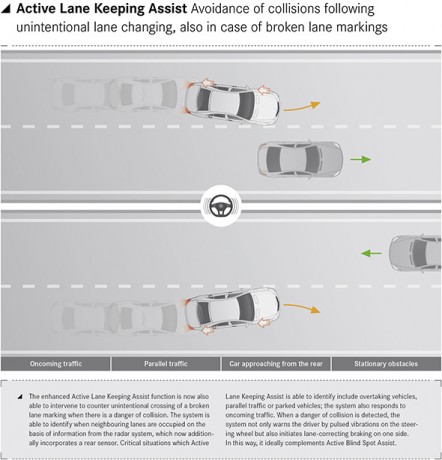
Detects broken lines too: Active Lane Keeping Assist
The new improved version of Active Lane Keeping Assist is now also able to intervene should the driver inadvertently cross a broken line when the neighbouring lane is not clear and changing lane could cause a collision as a result.
The system can determine if this is the case using the information from the stereo camera and the radar system. The latter has been supplemented by a sensor at the rear, which works in unison with the other sensors in the front and rear bumpers.
Active Lane Keeping Assist is not only capable of recognising critical situations such as overtaking vehicles, vehicles to be overtaken and parallel traffic, it can also respond effectively to oncoming traffic.
If the system detects the vehicle crossing the lane markings when the adjacent lane is not clear, not only does it cause the steering wheel to vibrate in pulses as a haptic warning for the driver, it guides the vehicle back into lane by single-sided braking via the ESP®.
It thereby forms the ideal complement to the Active Blind Spot Assist, and also makes it possible for the first time to prevent collisions with oncoming traffic together with their often serious consequences.
Active Lane Keeping Assist is active at speeds between 60 and200 km/h. If driver activity in the form of e.g. active steering, braking or acceleration is detected or when the indicators are switched on, both the warning and the corrective brake actuation are suppressed.
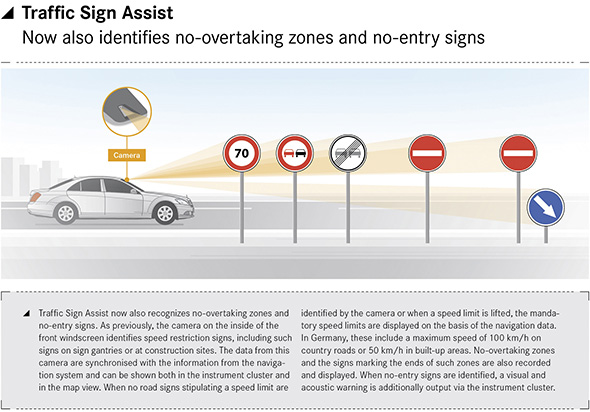
Now also recognises no-overtaking zones and access restrictions: Traffic Sign Assist
A new Traffic Sign Assist system which builds on the capabilities of the previous Speed Limit Assist represents yet another contribution to accident prevention from Mercedes-Benz. The system is now also able to recognise no-overtaking zones and alert drivers to access restrictions.
The camera on the inside of the windscreen continues to pick up speed limit signs, including those on overhead gantries and in roadworks, for example.
The camera’s data is cross-referenced against the information in the navigation system and can be displayed in both the instrument cluster and the map view. If the camera fails to spot any road signs showing a speed limit or a speed limit is lifted, the legal speed limits based on the navigation data are shown instead, such as a maximum speed of 100 km/h on country roads in Germany or 50 km/h in built-up areas.
No-overtaking zones and the signs signalling their end are also registered and displayed, while in the case of signs imposing access restrictions, an acoustic warning is additionally emitted together with a visual warning in the instrument cluster – an effective way of helping to prevent serious accidents caused by wrong-way drivers.
Visualising drowsiness: ATTENTION ASSIST
A quarter of all motorway accidents in Germany are put down to drowsiness, making it one of the most frequent causes of accidents, most of which are of a serious nature. In 2009, Mercedes-Benz presented ATTENTION ASSIST, which is able to detect tell-tale signs of inattentiveness and increasing drowsiness based on changes in steering behaviour and a host of other factors.
The system has been subject to ongoing development, and the latest version has the ability to detect drowsiness and inattentiveness across a far greater speed range from 60 -200 km/h. The system’s sensitivity can furthermore be adjusted, e.g. for drivers who already feel tired when they get behind the wheel.
A new menu in the instrument cluster display also makes the system more tangible and transparent for the driver by visualising the current ATTENTION ASSIST level and the driving time since the last break.
What’s more, it is also possible to see whether the system is active in the current driving situation. If the ATTENTION ASSIST warning recommending the driver to take a break is emitted, nearby service areas can be indicated in the navigation system.
The system can be deactivated by making the appropriate selection in the instrument cluster menu. However, it will always be automatically reactivated with the sensitivity setting last selected the next time the vehicle is started.
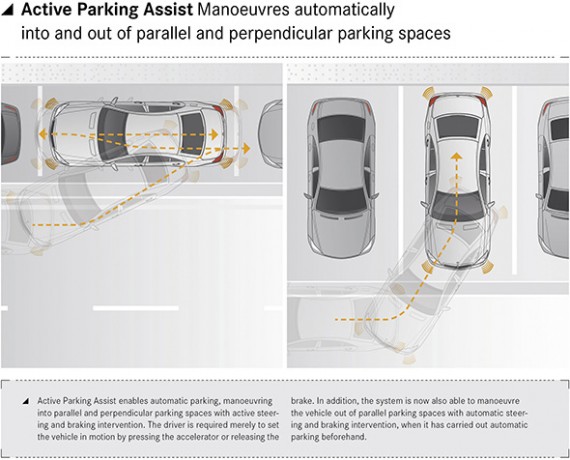
Automatic manoeuvring into and out of parallel and perpendicular parking spaces: Active Parking Assist
The Active Parking Assist is designed for automated parking with active steering and brake control in both parallel and perpendicular spaces. It is an advanced version of the PARKTRONIC system with Parking Guidance offered previously.
What’s more, the system is now also able to manoeuvre out of parallel parking spaces again all by itself with automatic steering and brake control, assuming the vehicle was parked there automatically previously.
When travelling at speeds below 30 km/h, ultrasonic sensors with an extended range in the bumpers’ side sections survey the nearside of the road for suitable parallel and perpendicular parking spaces. The same procedure is carried out for the far side of the road if the driver indicates accordingly.
A symbol in the instrument cluster shows that the system is in the process of measuring. If a suitable parking spot is identified, an arrow appears alongside the symbol indicating that the system is ready for automatic parking. All the driver now has to do to activate the system is engage reverse gear and confirm by pressing the OK button on the steering wheel.
Active Parking Assist steers and brakes the vehicle automatically as well as indicating the various driver actions required in the display, such as the transmission position to be selected. The driver moves the vehicle by lightly pressing the accelerator or releasing the brake.
Extended PRE-SAFE® protection
Prevention is better than cure
Ten years ago, Mercedes-Benz unveiled a ground-breaking safety concept in the form of the PRE-SAFE® anticipatory occupant protection system, which has been undergoing continuous refinement ever since. Now, the safety pioneer is increasing protection levels once again.
The new PRE-SAFE® functions can help to prevent collisions with pedestrians and vehicles in front in city traffic, defuse dangerous situations caused by traffic behind and enhance the protection offered by the seat belts.
Including pedestrian detection and City Brake function: BAS PLUS and PRE-SAFE® Brake
Pedestrian detection has been added to the BAS PLUS and PRE-SAFE® Brake functions, while autonomous braking for vehicles in front has undergone a major advance, too.
Thanks to the combination of stereo camera and radar sensors, it is now possible to detect pedestrians in front of the vehicle. Visual and acoustic warnings are triggered when a hazard is spotted. If the driver then reacts by braking, the braking power will be boosted by BAS PLUS as the situation requires, right up to a full brake application.
Should the driver fail to react, PRE-SAFE® Brake triggers autonomous vehicle braking. The PRE-SAFE® Brake with pedestrian detection is active up to approx. 72 km/h, and is able to prevent collisions with pedestrians autonomously from an initial speed of up to50 km/h.
Evaluations of GIDAS accident data carried out by Mercedes-Benz indicate that this new technology could avoid 6 percent of pedestrian accidents and reduce the severity of a further 41 percent. The operating range of the autonomous braking function for stationary vehicles has been optimised so that rear-end collisions can likewise be avoided at speeds of up to50 km/hnow.
BAS PLUS with Cross-Traffic Assist and PRE-SAFE® Brake with pedestrian detection rely on the same sensors employed for the adaptive cruise control system DISTRONIC PLUS with Steering Assist: the new stereo camera plus the multistage radar sensor system (see section “Under the microscope”).
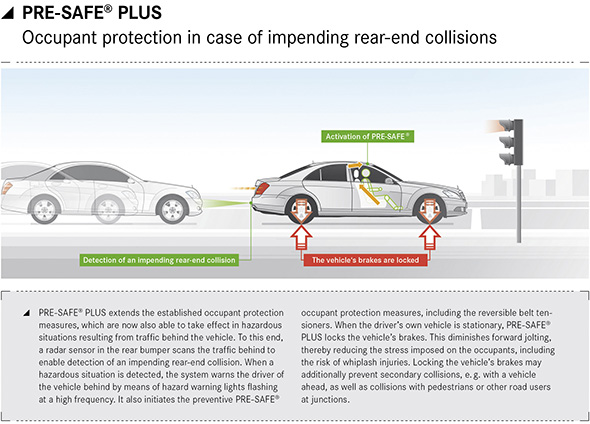
Safety measures in response to an imminent rear impact: PRE-SAFE® PLUS
PRE-SAFE® PLUS offers an extension of the familiar occupant protection measures in situations where traffic behind poses a danger. A radar sensor in the rear bumper monitors the traffic behind the vehicle. If the risk of an impact from the rear is detected, the rear hazard warning lights are activated to alert the driver of the vehicle behind (not on vehicles with USA/Canada coding).
Apart from this, the PRE-SAFE® anticipatory occupant protection measures, such as the reversible belt tensioners, are deployed.
Plus, if the vehicle is stopped and the driver indicates a wish to remain stationary – by depressing the brake pedal, for example, activating the HOLD function or moving the selector lever to “P” – PRE-SAFE® PLUS will also come to the driver’s aid by increasing the brake pressure in order to keep the vehicle firmly braked during a possible rear-end collision.
Keeping the vehicle firmly braked greatly reduces the strain placed on the occupants, such as the risk of whiplash injuries. At the same time, it serves to protect other road users by restricting uncontrolled vehicle movements after the initial impact that could lead to secondary collisions, such as running into a vehicle in front or colliding with pedestrians or other road users at junctions.
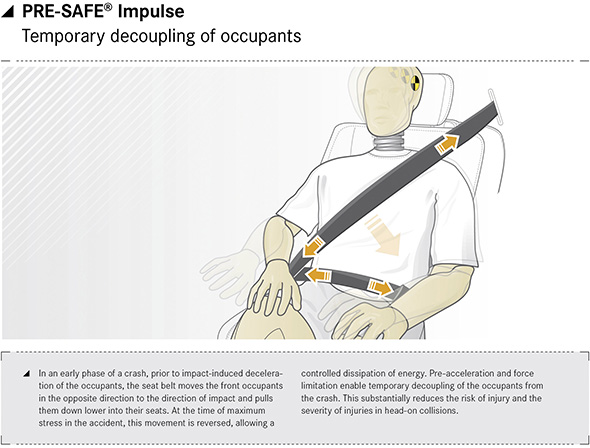
Intelligent countermovement: PRE-SAFE® Impulse
Mercedes-Benz is extending the front seat belt’s protective function with the introduction of PRE-SAFE® Impulse: at an early phase of the crash, before the resulting deceleration starts to increase, the front occupants are pulled away from the direction of impact and deeper into their seats by their seat belts.
By the time the accident enters the phase when loads peak, the extra distance they are retracted by can be used while dissipating energy in a controlled fashion. Pre-acceleration and force limitation allow the occupants to be temporarily isolated from the effects of the crash, significantly reducing the risk and severity of injuries in a frontal collision.
With PRE-SAFE® Impulse, the seat belt strap can be retracted by pyrotechnic means at all three belt anchorage points, and released again with controlled force. The fundamental difference compared to conventional belt tensioners is that the force for retracting the belt strap is maintained for a much longer time.
The deployment logic fires the seat belt system’s belt tensioners progressively depending on the severity of the accident. In this way, the tensioning force can be adapted as required. The PRE-SAFE® Impulse system is integrated in the seat’s structure and supplements the pyrotechnic reel tensioner with a pyrotechnic buckle and anchor fitting tensioner including central gas generator.
Extended protection in the rear
The seat belt gets into top shape
Mercedes-Benz is further reinforcing the safety system for passengers in the rear with the active seat-belt buckle and the beltbag. In contrast to many other manufacturers, the seat belts in the rear already include belt tensioners and belt force limiters today.
Both systems were furthermore developed with a particular view toward new markets. There, the occupancy rate in the rear is as much as 30 percent, making it much higher than in Europe. The two systems will be premiered in the next S-Class.
Reducing belt slack: the active seat-belt buckle
With the active seat-belt buckle, an electric motor extends and retracts the belt buckle automatically. In this way, any belt slack in the area of the pelvis and thorax can be reduced so that passengers are secured more firmly in both the sideways and the lengthways direction. The active seat-belt buckle fits in with Mercedes-Benz’s integral safety concept.
In keeping with an all-embracing approach to safety, this concept covers all phases of automotive safety: from safety while driving through safety in hazardous situations and protection in the event of an accident to minimisation of the consequences of accidents.
The innovation is classic Mercedes-Benz, improving safety and comfort in one. This is because fastening seat belts in the rear is also made much simpler: the seat belt buckle emerges from the upholstery when the rear doors are opened and is provided with an illuminated insertion slot.
Simplifying use of the seat belt in this manner may increase the percentage of rear passengers who buckle up. It also makes it easier to assist children or people who require help in fastening their seat belts.
The active seat-belt buckle is furthermore integrated in the PRE-SAFE® anticipatory safety system. This means that whenever PRE-SAFE® becomes active in critical driving situations or when the system detects the vehicle approaching other objects at a critical speed, reversible belt tensioning is also performed in the rear via the active seat-belt buckle function.
The restraint system and the passengers are thus better prepared for a possible accident situation. In this way, the active seat-belt buckle complements the pyrotechnic belt tensioning which has featured as standard on all outer rear seats in Mercedes-Benz vehicles for many years now, and is triggered in the event of an impact exceeding a certain severity.
The active seat-belt buckle is a motorised belt buckle which can be extended upwards by70 millimetresand retracted by40 millimetres. The belt buckle is attached via a cable to a nut which runs on a spindle, translating the electric motor’s rotary movement into a linear movement.
The following functions are carried out by means of this movement:
- Seat belt reminder/fastening aid: the active seat-belt buckle is provided with an illuminated insertion slot, attracting the occupants’ attention to the buckle. Particularly in the dark, this makes it easier to find the belt buckle and connect it with the seat belt tongue. In addition, the belt buckle is extended by70 millimetres when occupants enter the rear of the vehicle, to facilitate fastening of the seat belt. When extended, the belt buckle is more readily accessible and it is easier to insert the belt tongue. Both functions are activated when the doors are opened by passengers entering the rear of the vehicle.
- Minimised belt slack: after the belt tongue has been inserted, the belt buckle returns to its original position. This reduces any belt slack in the area of the pelvis and thorax, and ensures that the belt fits correctly in the pelvis area.
- PRE-SAFE® function for rear occupants: the active seat-belt buckle is fully integrated in the vehicle’s PRE-SAFE® system. Whenever PRE-SAFE® becomes active in critical driving situations or when the system detects the vehicle approaching other objects at a critical speed, reversible belt tensioning is also performed in the rear via the active seat-belt buckle function. The restraint system and the passengers are thus better prepared for a possible accident system. In contrast to its extended position to facilitate fastening of the seat belt, the belt buckle is retracted by approx. 40 millimetres instead. This reversible function increases the belt tensioning on the occupant by up to 80 millimetres. In addition, the belt buckle branches off at a lower point at the occupant’s hip. This reduces the risk of the pelvis submarining under the belt. Securing the occupants more effectively in this way can reduce the strain to which they are exposed in the event of an accident. The active seat-belt buckle complements the pyrotechnic belt tensioning which has featured as standard in Mercedes-Benz vehicles for many years now, and is triggered in the event of an actual impact.
- POST-SAFE functionality: to facilitate the rescue of occupants and to assist rescue personnel or the occupants themselves in unbuckling the seat belts, the belt buckle is extended once again as soon as the doors are opened by rescue personnel or the occupants themselves after the system has detected a crash and the vehicle has come to a standstill, provided that the on-board electrical system is intact. The raised belt buckle position allows better access from inside the vehicle, while illumination of the buckle draws attention to the belt’s opening mechanism.
An airbag for seat belts: the beltbag
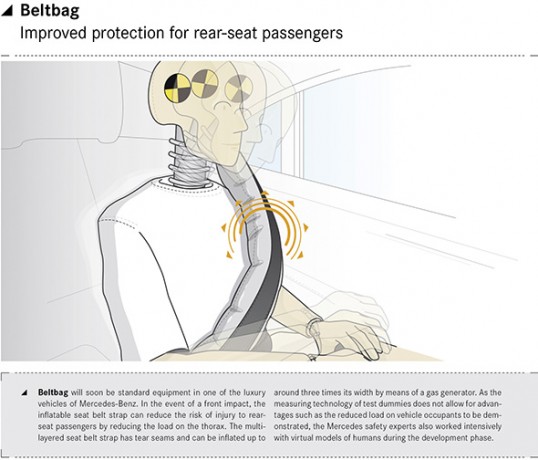
The beltbag is an inflatable seat-belt strap that is able to reduce the risk of injury to passengers in the rear in a head-on collision by lessening the strain placed on the ribcage.
Should the crash sensors detect a severe frontal impact, the airbag control unit will trigger deployment and inflation of the beltbag. A gas generator then inflates the multi-layered belt strap with Velcro seams to nearly three times its normal width. The resulting larger surface area is able to better distribute the force acting on the seat occupant, thereby reducing the risk of injury.
The beltbag is used in exactly the same way as a conventional seat belt. The belt strap’s design is different from that of the standard belt though, and received praise in practical trials for being extremely comfortable to wear and for its extra-soft belt strap edge.
Under the microscope: an unconventional development tool
Virtual human models
The Mercedes-Benz safety experts have developed the active seat-belt buckle and beltbag with the aid of virtual human models, which provide a clearer picture of what happens to a vehicle’s occupants in an accident than crash test dummies. For these digital models simulate not only the human body’s outer form, but also its internal structures, such as bones and soft tissue.
“All the crucial biological features of humans – joints, muscles, tendons, ligaments, bones – can only be simulated in very rough terms with dummies,” explains Dr Hakan Ipek, expert for virtual human models at Mercedes-Benz. “Some seated positions, such as when a rear passenger is dozing and the belt does not pass over the pelvis in the correct manner, simply cannot be recreated with a dummy,” he adds.
With virtual human models, on the other hand, the biomechanical characteristics of the human body are simulated in detail on a computer, enabling examination of the stresses to which the model is exposed in a virtual crash test.
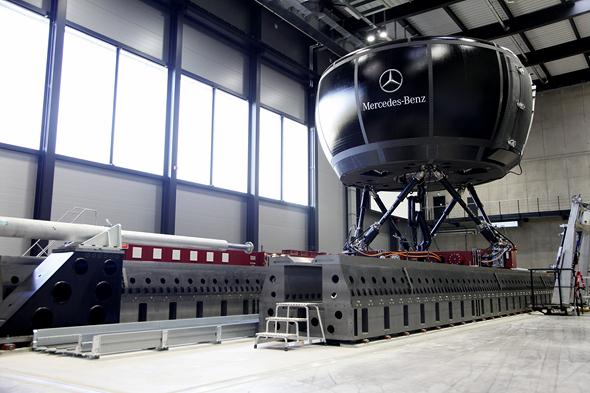
More light and sight
The first ever car without a single light bulb
100 years or so after the introduction of electric lighting in motor vehicles, Mercedes-Benz is now making a complete switch to LED technology – next year, the new S-Class will become the first vehicle in the world to do without a single light bulb as standard.
The lighting’s multi-level functionality is another world first: out of consideration for any road users behind, the intensity of the brake lights is reduced at night-time or while waiting at traffic lights. Meanwhile, visibility is enhanced by two assistance systems that have undergone some key improvements – Adaptive Highbeam Assist PLUS and Night View Assist PLUS.
Mercedes-Benz is due to further underline its pioneering role in the field of lighting technology: the new S-Class that is coming onto the market next year will not have a single light bulb on board. Over 190 LEDs will assume the task of illuminating the road, vehicle, interior and luggage compartment instead.
“With its long life and a colour temperature resembling daylight, LED technology already had a great deal in its favour,” remarks Prof. Dr. Thomas Weber, Member of the Daimler Board of Management responsible for Group Research and Head of Mercedes-Benz Cars Development. “Now, though, our engineers have made great advances where energy efficiency is concerned too, reducing power consumption to a quarter of that of conventional headlamps.”
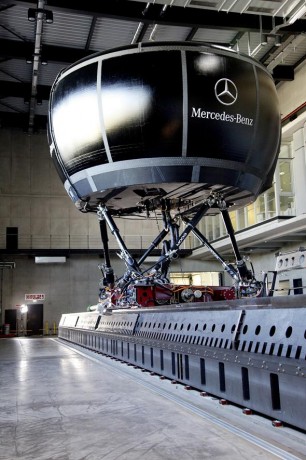
The new energy-saving LED low-beam headlamps, for instance, require 34 watts to produce the same light output, making them notably more efficient than halogen (120 watts) and xenon light sources (84 watts, all figures per vehicle).
This translates into a saving of up to 0.05 litres of fuel per 100 kilometres or 2.1 grams of CO2 per kilometre compared to a vehicle fitted with halogen low-beam headlamps. Efficiency is given a further crucial boost by new, high-performance single-chip LED diodes and a newly developed projector module in the headlamp unit, in which deflected beams of light are reflected back again.
Even the entry-level model in the new luxury saloon range will come with all-LED lighting. The supplementary functions of the Intelligent Light System as well as Adaptive Highbeam Assist PLUS can be added as options.
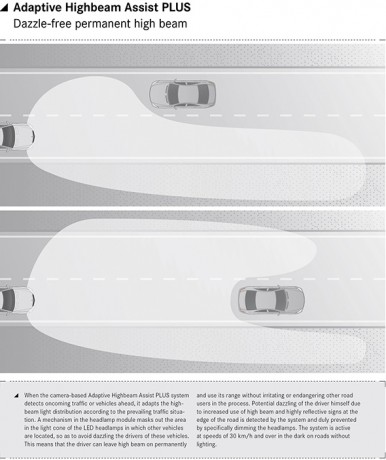
Permanent high beam with no dazzling: Adaptive Highbeam Assist PLUS
For the first time, the Adaptive Highbeam Assist PLUS allows the high-beam headlamps to be kept on permanently while driving by masking out other road user detected in the beams’ cone of light. If the camera-based system registers either oncoming traffic or vehicles ahead, it will adapt the light distribution according to the specific situation when the high beam is switched on.
Consequently, the driver can simply leave the high-beam headlamps on at all times and use their full range without irritating or even endangering other road users. There is no need to switch them on and off manually, resulting in a significant increase in the overall driving time with high beam.
Adaptive Highbeam Assist PLUS likewise makes use of the new stereo camera also employed by other assistance systems. If its image recognition algorithm picks up a vehicle that is oncoming or driving ahead, it actuates a mechanism in the headlamp module.
This then masks the portion of the LED headlamp’s high-beam cone of light where there are other vehicles to prevent their drivers being dazzled. If road users are detected outside the area that
can be masked – for instance when cornering with multiple vehicles in the headlamps’ beams – the system will switch to the familiar system of headlamp range control using the low-beam headlamps.
Possible backglare caused by increased use of the main beam and highly reflective signs at the side of the road is also detected and eliminated by dimming the headlamps accordingly.
Adaptive Highbeam Assist PLUS builds on the Adaptive Highbeam Assist system first introduced by Mercedes-Benz in 2009. If this system detects oncoming traffic or traffic driving ahead with the help of a camera, it dips the headlamps and automatically adapts the low beam’s range according to the situation.
In this way, it allows the road to be illuminated for a long way ahead without dazzling other drivers. In addition to this, adaptive control of the low-beam headlamp range with smooth transitions results in gentler lighting changes that the eyes can adjust to fast.
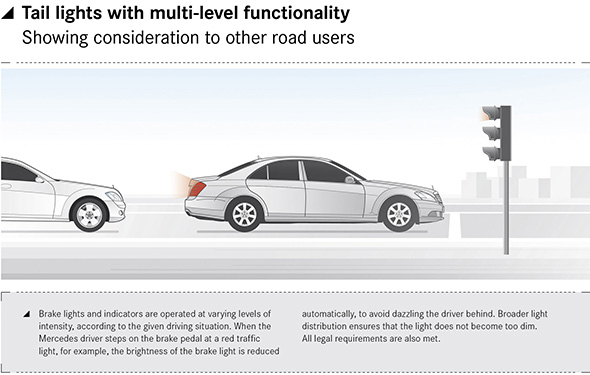
Considerate to others: tail lights with automatic intensity control
The new S-Class shows itself to be highly considerate of its fellow road users in another way, too: Mercedes-Benz has achieved yet another world first by developing tail lights with multi-level functionality, meaning that the brake lights and indicators are operated at varying intensities depending on the current driving state and ambient brightness levels (day/night).
If the Mercedes driver presses the brake pedal while stopped at traffic lights, for instance, the brightness of the brake lights will be automatically dimmed to avoid dazzling anyone behind. The light distribution is broadened to ensure the lights do not become too dim and continue to fulfil all legal requirements.
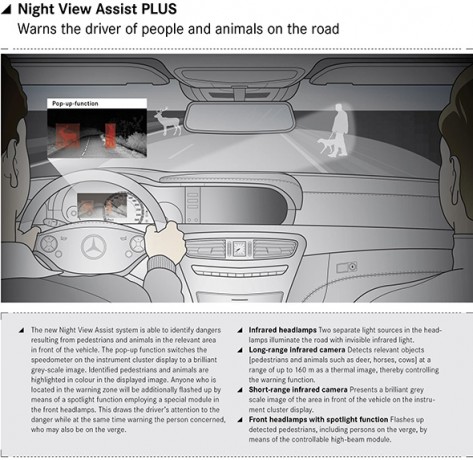
Detects pedestrians and animals: the advanced Night View Assist PLUS
For the first time, the new Night View Assist PLUS is capable of detecting not just pedestrians in potentially hazardous positions in front of the vehicle, but animals too. This third-generation night vision system automatically switches the instrument cluster display from the speedometer to a crystal-sharp night view image to alert the driver in unlit areas.
Pedestrians or animals detected ahead are highlighted in colour in this image.
The spotlight function is additionally used to repeatedly flash pedestrians in the warning zone by means of a special module in the front headlamps. This attracts the driver’s attention to the source of the danger at the same time as warning the person on the side of the road. The pedestrian detection function is now also available in urban areas with the night view image has been activated by the driver.
An additional (far) infrared sensor in the radiator grille supplements the proven Mercedes-Benz night vision technology. It is able to detect pedestrians at a distance of up to160 metres, and animals such as deer, horses and cattle at up to100 metres.
Two separate light sources in the headlamp assemblies light up the area in front of the vehicle with invisible infrared light. This enables the near infrared camera positioned behind the windscreen next to the rear-view mirror to produce a sharp greyscale image in the instrument cluster display. This image can also be shown in the display permanently if desired at the press of a button.
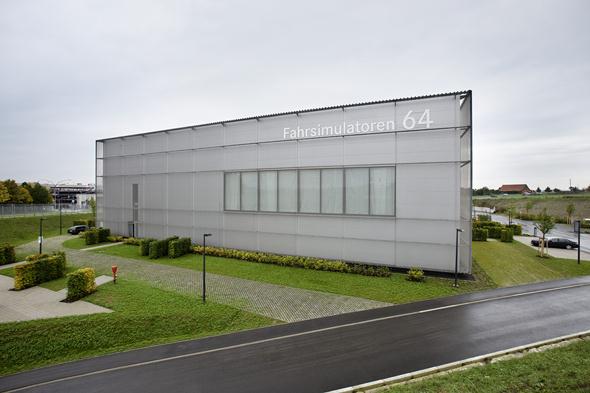
Driving simulator
Fast response and a photorealistic environment
With its 360° screen, fast electric power system and the twelve-metre-long rail for transverse or longitudinal movements, the new “Moving Base” simulator from Mercedes-Benz is the most powerful in the entire car industry. It went into operation at the end of 2010.
“With the simulator, we are able to realistically reproduce highly dynamic driving manoeuvres such as lane-changing and therefore research the behaviour of the driver and the vehicle in road traffic in great depth,” explains Prof. Dr. Thomas Weber, Member of the Daimler Board of Management responsible for Group Research and Head of Mercedes-Benz Cars Development.
The system is not intended to replace real test drives entirely. The simulator will enable systems and components for future Mercedes models to be tested throughout all development phases, however.
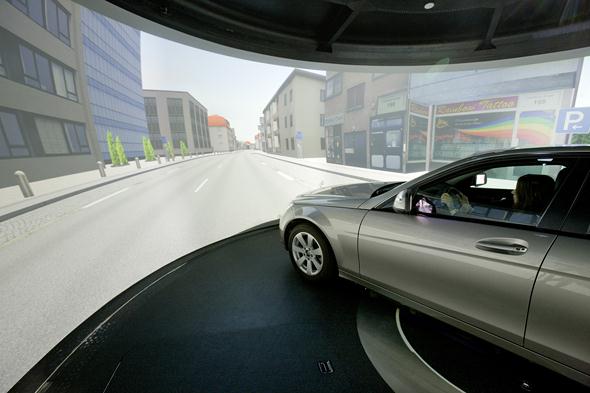
The driving simulator is furthermore used to conduct trials with test subjects. During these, normal car drivers are able to approach the physical limits of driving performance with absolutely no danger, providing the Mercedes engineers with invaluable findings on the acceptance and operation of new safety systems.
How the simulator works
The simulator cell is basically a cab fixed to a hexapod on six moveable supports. Inside there is a complete Mercedes model in which the test driver is seated, as well as the 360° projection screen showing a realistic image of the traffic scenario, with moving pedestrians, oncoming traffic and houses.
The vehicle controls are linked to the computerised control system of the driving simulator by data lines. When the test driver turns the steering wheel, accelerates or operates the brakes, these reactions are registered by the computer control system and have the same effects as in real traffic situations.
The scenery on the screen changes constantly, while the hexapod and the linear movements combine together to create a realistic impression of vehicle motion. The computer calculates the driving behaviour of the car more than 1000 times per second, issuing the relevant commands to the electrics.
It is able to move the cell transversely by up to twelve metres at a maximum speed of ten metres per second (36 km/h), so that double lane-changes can also be simulated, for example.
Equally high-tech: part of the energy required to operate the simulator is recovered by means of energy recuperation during braking and fed into the power network of the Sindelfingen plant.
In its role as a safety pioneer, Mercedes-Benz has long led the way in the use of simulators, too. The first driving simulator, an in-house development, was commissioned at the Daimler-Benz research centre in Berlin-Marienfelde over 25 years ago.

Under the microscope: history
Setting the pace for safety technology
The luxury-class models from Mercedes-Benz are always at the vanguard of the very latest automotive technology. Time and time again, they showcase brand new features which then come into widespread use. Here’s an overview of the safety innovations premiered by the individual S-Class model series:
Models 220 b/220 Sb/220 SEb/300 SE/300 SE long wheelbase, W 111/W 112 (1959 to 1965)
- Safety passenger compartment with crumple zones (front and rear)
- Padded steering wheel and “injury-proofed” interior
- Wedge-pin door locks with two safety detents
- Disc brakes (300 SE, from 1961)
- Dual-circuit braking system (from 1963)
Models 250 S to 300 SEL 6.3, W 108/W 109 (1965 to 1972)
- Safety steering system (from 1967)
- Hydropneumatic equalising springs at the rear axle
S-Class 116 series (1972 to 1980)
- Integral safety concept
– four-spoke safety steering wheel
– fuel tank installed above the rear axle for collision protection
– safety door handles
– large headlamp units and indicators
– tail lights with low dirt build-up
– side windows with low dirt build-up
- Anti-lock braking system ABS as optional extra (from 1978)
S-Class 126 series (1979 to 1991)
- Bodyshell with fork-arm structure, the world’s first series-production car to fulfil the criterion of the asymmetric head-on collision (offset crash)
- Driver’s airbag and belt tensioner for front passenger as optional extra (from 1981)
- Front passenger airbag (from 1988)
S-Class 140 series (1991 to 1998)
- Speed-sensitive power steering
- Seat belts with automatic height adjustment
- Sidebags for driver and front passenger (from 1996)
- Electronic Stability Program ESP® as standard (S 600, from 1995)
- or optional extra (S 420, S 500, from 1995)
- Brake Assist BAS (from 1996)
S-Class 220 series (1998 to 2005)
- Aluminium crash boxes in the front and rear-end structure
- AIRMATIC air suspension with electronically controlled Adaptive Damping System
- Active Body Control as optional extra (standard on S 600)
- Additional indicator lamps integrated into the exterior mirrors
- Windowbags, sidebags in the rear
- Front passenger airbag with two-stage gas generator
- Belt tensioners and belt force limiters in the rear
- Laminated glass for side windows
- DISTRONIC proximity control as optional extra PRE‑SAFE®
- PRE‑SAFE® anticipatory occupant protection system (from 2002)
S-Class 221 series (2005 onwards)
- Active Body Control with crosswind stabilisation as optional extra (standard on S 600)
- ADAPTIVE BRAKE system
- Adaptive brake lights
- Brake Assist PLUS as optional extra
- Improved DISTRONIC PLUS proximity control (with braking to a stop) as optional extra
- PRE-SAFE® Brake with autonomous partial braking (from 2006) or autonomous full brake application (from 2009) as optional extra
- Active Night View Assist as optional extra (from 2009 as Night View Assist PLUS with pedestrian detection)
- Blind Spot Assist as optional extra (from 2007, from 2010 as Active Blind Spot Assist )
- Lane Keeping Assist as optional extra (from 2009, from 2010 as Active Lane Keeping Assist)
- Adaptive Highbeam Assist as optional extra (from 2009)
- ATTENTION ASSIST drowsiness detection system (from 2009)
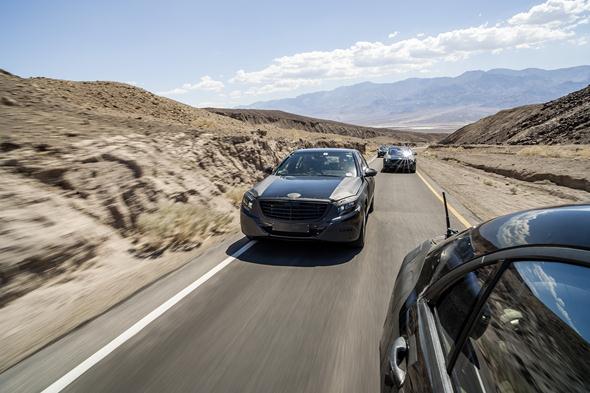
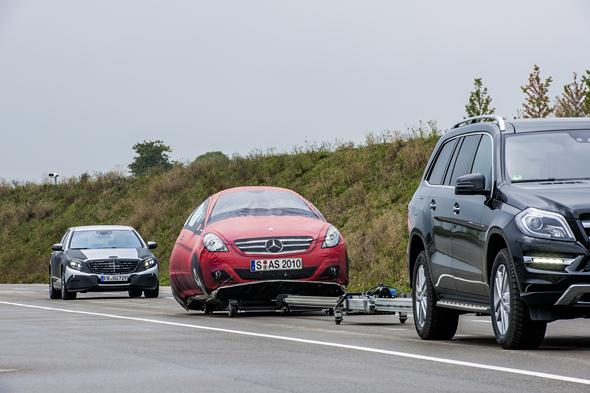
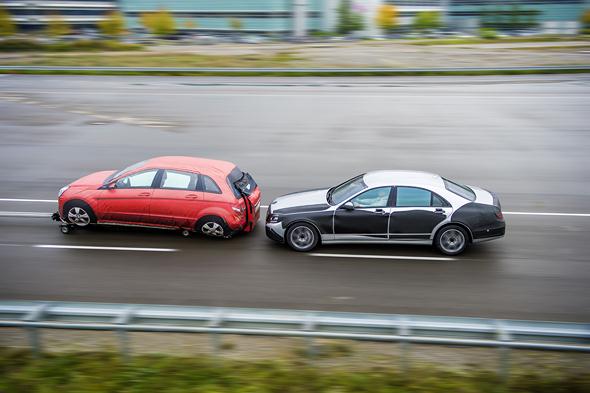
Glossary
Terms and innovations from A to Z
| Adaptive Highbeam Assist PLUS: permanent main beam with no dazzling. If the camera-based Adaptive Highbeam Assist PLUS picks up oncoming traffic or vehicles ahead, it adapts the light distribution according to the specific situation when the main beam is on. A mechanism in the headlamp module masks the portion of the LED headlamps’ cone of light where there are other vehicles to prevent their drivers being dazzled. Possible backglare caused by increased use of the main beam and highly reflective signs at the side of the road is also detected and eliminated by dimming the headlamps accordingly. Consequently, the driver can simply leave the main-beam headlamps on at all times and use their full range without irritating or even endangering other road users. The system is active at speeds above30 km/h when travelling in the dark on roads without street lighting. |
| Active seat-belt buckle: comfort and safety. An electric motor extends and retracts the belt buckle automatically. In this way, any belt slack in the area of the pelvis and thorax can be reduced so that passengers are secured more firmly in both the sideways and the lengthways direction. Fastening seat belts in the rear has also been made simpler: the seat belt buckle emerges from the upholstery when the rear doors are opened and is provided with an illuminated insertion slot. |
| Active Parking Assist: automatic manoeuvring into and out of parallel and perpendicular parking spaces. The Active Parking Assist is designed for automated parking with active steering and brake control in both parallel and end-on spaces. The driver moves the vehicle by manually pressing the accelerator or releasing the brake. What’s more, the system is now also able to manoeuvre out of parallel parking spaces again all by itself with automatic steering and brake control, assuming the vehicle was parked there automatically previously. |
| Active Lane Keeping Assist: intervention to correct unintentional lane changes even with a broken line. The new improved version of the Active Lane Keeping Assist is now also able to intervene should the driver inadvertently cross a broken line when there is a risk of a collision. The system uses the information from the radar system to detect when the adjacent lane is not clear. The radar system has been supplemented by a sensor at the rear, which works in unison with the other sensors in the front and rear bumpers. The Active Lane Keeping Assist is not only capable of recognising critical situations such as overtaking vehicles, parallel traffic and parking vehicles, it can also respond effectively to oncoming traffic. If the system detects the risk of a collision, not only does it cause the steering wheel to vibrate in pulses as a haptic warning for the driver, it intervenes with lane-correcting single-sided braking via the ESP®. It thereby forms the ideal complement to the èActive Blind Spot Assist. |
| Active Blind Spot Assist: warning for lane changes. This radar-based system alerts the driver if it detects another vehicle in the blind spot when changing lanes. If the driver ignores the system’s warnings and comes dangerously close to the vehicle in the adjacent lane, Active Blind Spot Assist intervenes by applying the brakes at the wheels on the opposite side of the vehicle to create a yawing movement that can avert a collision. |
| BAS PLUS with Cross-Traffic Assist: braking assistance also for crossing traffic. For the first time, the Brake Assist system BAS PLUS with Cross-Traffic Assist can help to avoid not just rear-end collisions with vehicles directly in front, but also imminent crashes with cross traffic at junctions. If the anticipatory system detects a hazardous situation of this type based on the amalgamated data from the new èstereo camera and the radar sensor system, it prompts the driver to start emergency braking by activating visual and acoustic warnings. If the driver presses the brake pedal too tentatively, as is often the case, BAS PLUS will step in by automatically boosting brake pressure for effective emergency braking, even applying the brakes at full power if necessary. The Cross-Traffic Assist is active at speeds up to72 km/h. |
| BAS PLUS and PRE-SAFE® Brake: preventing traffic accidents with pedestrians and vehicles in front. Pedestrian detection has been added to the BAS PLUS and PRE-SAFE® Brake functions, while autonomous braking for vehicles in front has undergone a major advance. By fusing the data from the stereo camera and radar sensors, it is now possible to detect pedestrians in front of the vehicle. Visual and acoustic warnings are given when a hazard is spotted. If the driver then reacts by braking, the braking power will be boosted by BAS PLUS as the situation requires, right up to a full brake application. Should the driver fail to react, the PRE-SAFE® Brake will trigger autonomous vehicle braking. The pedestrian detection is active up to approx. 72 km/h, and is able to prevent collisions with pedestrians from an initial speed of up to50 km/h.The operating range of the autonomous braking function for stationary vehicles has been optimised so that rear-end collisions can likewise be avoided at speeds of up to50 km/hnow. |
| Beltbag: reduces the risk of injury to passengers in the rear. This inflatable seat-belt strap is able to reduce the risk of injury to passengers in the rear in a head-on collision by lessening the strain placed on the ribcage. Should the crash sensors detect a severe frontal impact, the airbag control unit will trigger deployment and inflation of the beltbag. A gas generator then inflates the multi-layered belt strap with Velcro seams to nearly three times its normal width. The resulting larger surface area is able to better distribute the force acting on the seat occupant, thereby reducing the risk of injury. |
| Data fusion: amalgamation for reliable operation. Highly sophisticated sensors and the necessary networked algorithms provide the foundation for innovative new functions. Data fusion enables the algorithms for the varying systems to amalgamate the visual information from the èstereo camera with the readings from the èradar sensors. Many of the assistance systems from Mercedes-Benz work in this way, fusing multiple or complementary data sources to ensure reliable operation. |
| DISTRONIC PLUS with Steering Assist: comfort-enhancing assistance with lateral lane guidance. The DISTRONIC PLUS proximity control system is a driver aid designed to keep the vehicle at the desired distance from another vehicle in front, even in stop & go traffic. This basic radar-based function has now been enhanced by the addition of a Steering Assist, which helps drivers to stay centred in their lane by generating the appropriate steering torque when travelling on a straight road and even in gentle bends. The èstereo camera recognises lane markings as well as a vehicle driving ahead, and relays this information to the electric steering assistance system. When driving at slow speeds, e.g. in congested traffic, the Steering Assist can use the vehicle ahead as a means of orientation, even when there are no clear lane markings visible.The system’s design is so refined that the sensors can detect whether the driver’s hands are actually on the steering wheel. If they are not, a visual warning is issued first. Should the driver fail to react, a warning signal sounds and lateral lane guidance is deactivated. The system can be activated at speeds up to200 km/h. A green steering wheel symbol appears in the instrument cluster to indicate when the Steering Assist is operating while DISTRONIC PLUS is activated.
|
| Infrared headlamps:two separate light sources in the headlamp assemblies light up the road ahead with invisible infrared light. Used for the Night View Assist PLUS. |
| Far-infrared camera:detects relevant objects (pedestrians and animals such as deer, horses, cattle) at a distance of up to160 m as a thermal image, enabling it to control the warning function. Used for the Night View Assist PLUS. |
| Multi-level functionality: dazzle protection for following traffic. The intensity of the brake lights is reduced at night-time or while waiting at traffic lights out of consideration for any road users behind. |
| Night View Assist PLUS: alerting to pedestrians and animals. The new Night View Assist PLUS is capable of detecting pedestrians and animals in potentially hazardous positions in front of the vehicle. It automatically switches the instrument cluster display from the speedometer to a crystal-sharp night view image to alert the driver in unlit areas. Pedestrians or animals detected ahead are clearly highlighted in colour in this image. The èspotlight function is additionally used to repeatedly flash pedestrians in the warning zone by means of a special module in the front headlamps. This attracts the driver’s attention to the source of the danger at the same time as warning the person on the side of the road. These functions are now available in urban areas, too.èInfrared headlamps, a èlong-range infrared camera, a èshort-range infrared camera and a èspotlight function are used to provide the various functions. |
| Near infrared camera:shows a sharp greyscale image of the area in front of the vehicle in the instrument cluster display. Used for the Night View Assist PLUS. |
| PRE-SAFE® Impulse: at an early phase of the crash, before the resulting deceleration starts to increase, the front occupants are pulled away from the direction of impact and deeper into their seats by their seat belts. By the time the accident enters the phase when loads peak, the extra distance they are retracted by can be used while dissipating energy in a controlled fashion. Pre-acceleration and force limitation allow the occupants to be temporarily isolated from the effects of the crash, significantly reducing the risk and severity of injuries in a frontal collision. With PRE-SAFE®Impulse, the seat belt strap can be retracted by pyrotechnic means at all three belt anchorage points, and released again with controlled force. The fundamental difference compared to conventional belt tensioners is that the force for retracting the belt strap is maintained for a much longer time. The deployment logic fires the seat belt system’s belt tensioners progressively depending on the seriousness of the accident. In this way, the tensioning force can be adapted as required. |
| PRE-SAFE® PLUS: occupant protection for an imminent impact from the rear. PRE-SAFE® PLUS offers an extension of the familiar occupant protection measures in situations where traffic behind poses a danger. A radar sensor in the rear bumper monitors the traffic behind the vehicle and can detect the risk of a rear-end collision. The system warns the driver of the vehicle behind by activating the rear hazard warning lights at a higher frequency than normal. Apart from this, the PRE-SAFE® anticipatory occupant protection measures, including the reversible belt tensioners, are also deployed. If the vehicle is stationary, PRE-SAFE®PLUS will keep it firmly braked. Minimising the forward jolt in this way can greatly reduce the strain placed on the occupants, such as the risk of whiplash injuries. Firmly applying the vehicle’s brakes can help to prevent secondary accidents too, such as running into a vehicle in front, for example, or colliding with pedestrians or other road users at junctions. |
| Radar: sensor technology for picking up relevant obstacles. New improved versions of the short-range and long-range radars combine with a new multi-mode radar to detect relevant obstacles such as vehicles or people in defined areas in front of, next to and, now, behind the vehicle, too. The system employs 2 x short-range radars at the front (range 30 m, opening angle 80°), 1 x long-range radar at the front (200 m, 18°) with mid-range scan (60 m, 60°), 2 x short-range radars on the sides at the rear (30 m, 80°) and 1 x multi-mode radar at the rear (30 m, 80° and 80 m, 16°).The algorithms for the varying systems amalgamate (èdata fusion) the radar readings with the visual information from the èstereo camera. Many of the assistance systems from Mercedes-Benz work in this way, fusing complementary data sources to ensure reliable operation. |
| Spotlight function in the front headlamps: flashes pedestrians detected with the help of the controllable main beam module. Used for the Night View Assist PLUS. |
| Stereo Multi-Purpose Camera (SMPC, stereo camera for short): 3D vision. Just like the Multi-Purpose Camera (MPC) fitted previously, the stereo camera is positioned behind the windscreen in the vicinity of the rear-view mirror. However, the camera features two “eyes” that produce a 3D view of the area up to around50 metres in front of the vehicle while monitoring the overall situation ahead for a range of up to500 metres. In this way, the camera is able to provide data for processing by various systems. Intelligent algorithms perform a visual evaluation of this three-dimensional information in order to detect and carry out spatial classification of both vehicles that are driving ahead, oncoming or crossing, as well as pedestrians and a variety of traffic signs within a large field of vision. Used for example for BAS PLUS with Cross-Traffic Assist and DISTRONIC PLUS with Steering Assist. |
| Traffic Sign Assist: now recognises no-overtaking zones and access restrictions, too. The new Traffic Sign Assist, which builds on the capabilities of the previous Speed Limit Assist, represents yet another contribution to accident prevention from Mercedes-Benz. The system is now also able to recognise no-overtaking zones and alert drivers to access restrictions. The camera on the inside of the windscreen continues to pick up speed limit signs, including those on overhead gantries and in roadworks, for example. The camera’s data is cross-referenced against the information in the navigation system and can be displayed in both the instrument cluster and the map view. If the camera fails to spot any road signs showing a speed limit or a speed limit is lifted, the legal speed limits based on the navigation data are shown instead, such as a maximum speed of 100 km/h on country roads in Germany or 50 km/h in built-up areas. No-overtaking zones and the signs signalling their end are also registered and displayed, while in the case of signs imposing access restrictions, an acoustic warning is additionally emitted together with a visual warning in the instrument cluster. |





